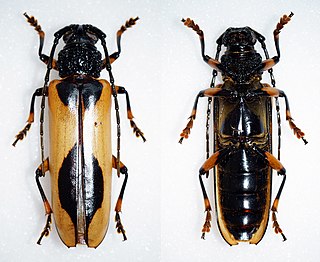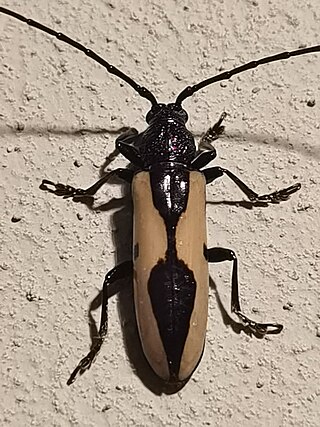
Coleoxestia is a genus of Long-Horned Beetles in the beetle family Cerambycidae. There are more than 50 described species in Coleoxestia, found mainly in Central and South America.

Criodion is a genus of Long-Horned Beetles in the beetle family Cerambycidae. There are about 11 described species in Criodion.

Metacriodion is a genus of longhorn beetles in the family Cerambycidae. There are at least two described species in Metacriodion.

Poeciloxestia is a genus of longhorn beetles in the family Cerambycidae. There are more than 20 described species in Poeciloxestia, found in Central and South America.
Coleoxestia errata is a species in the longhorn beetle family Cerambycidae. It is found in Bolivia and Brazil.
Coleoxestia atrata is a species in the longhorn beetle family Cerambycidae. It is found in Bolivia, Brazil, Colombia, and South America.
Coleoxestia femorata is a species in the longhorn beetle family Cerambycidae. It is found in Bolivia and Brazil.
Coleoxestia pubicornis is a species in the longhorn beetle family Cerambycidae. It is found in Brazil and Bolivia.

Coleoxestia rubromaculata is a species in the longhorn beetle family Cerambycidae. It is found in Brazil, Colombia, Costa Rica, Ecuador, Honduras, Nicaragua, Panama, and South America.
Coleoxestia waterhousei is a species in the longhorn beetle family Cerambycidae. It is found in Argentina, Bolivia, Brazil, Paraguay, and Uruguay.
Coleoxestia pirrensis is a species in the longhorn beetle family Cerambycidae. It is found in Panama.
Coleoxestia glabripennis is a species in the longhorn beetle family Cerambycidae. It is found in Bolivia and Brazil.

Coleoxestia sanguinipes is a species in the longhorn beetle family Cerambycidae. It is found in Nicaragua, Panama, Venezuela, Ecuador, Colombia, Costa Rica, and Honduras.
Coleoxestia corvina is a species in the longhorn beetle family Cerambycidae. It is found in Uruguay, Paraguay, Brazil, Argentina, and Bolivia.
Coleoxestia denticornis is a species in the longhorn beetle family Cerambycidae. It is found in Bolivia, Brazil, and Paraguay.
Coleoxestia ebenina is a species in the longhorn beetle family Cerambycidae. It is found in Argentina, Bolivia, and Brazil.
Coleoxestia julietae is a species in the longhorn beetle family Cerambycidae. It is found in Bolivia.
Coleoxestia olivieri is a species in the longhorn beetle family Cerambycidae. It is found in Bolivia, French Guiana, and Brazil.
Coleoxestia rufosemivittata is a species in the longhorn beetle family Cerambycidae. It is found in Bolivia.
Coleoxestia vittata is a species in the longhorn beetle family Cerambycidae. It is found in Honduras, Brazil, Paraguay, Panama, Costa Rica, Bolivia, Argentina, and Guatemala.





